Jan 14
“Facts are observed and catalogued by the systematizers, and then suddenly, as if by chance, an idea is born that introduces order and logic into what was chaos, and we are in possession of a guiding principle, of an instrument of thought and investigation, that may transform the whole of our relation to knowledge or alter the face of the physical globe.” (Broadview Reader in Book History 4)
We’ll see if this actually happens…
xXx
Fairy Tales / from the German of A. L. Grimm; with ill. Cruikshank.
Published 1827
By Grimm, Albert Ludwig, 1786-1872
Other authors Cruikshank, Robert 1789-1856
Jan 14
So small!
hard cover with a brown marble cover design
Printed with illustrations
There’s a hole on page 45/46!
Bottom of page10 is a little torn
“The page is the atom of the book, its most basic building block…where words assume order, and it is that order that has helped shape the meaning of words for us.” (Broadview Reader in Book History 512)
• On certain pages, the bottom of the page looks less even or not “cut” – possibly end of the sheet of paper printed so a little uneven?
There is random numbering at the bottom center of certain pages (not all) in addition to page numbers on the top corners
• Some labelled B3, C, C3, D, D3, etc.
• Has something to do with proper order of printing? Or for another reason?
Little stamp / symbol signalling the end of a short story
Even has footnotes one of the pages – is this because it is translated and certain phrases need to be explained in better context?
xXx
“Wind rose, a medieval depiction of four charts of the wind, an early predecessor to the compass rose”
Andrew McCormick Collection
Call # QC931.8.W56
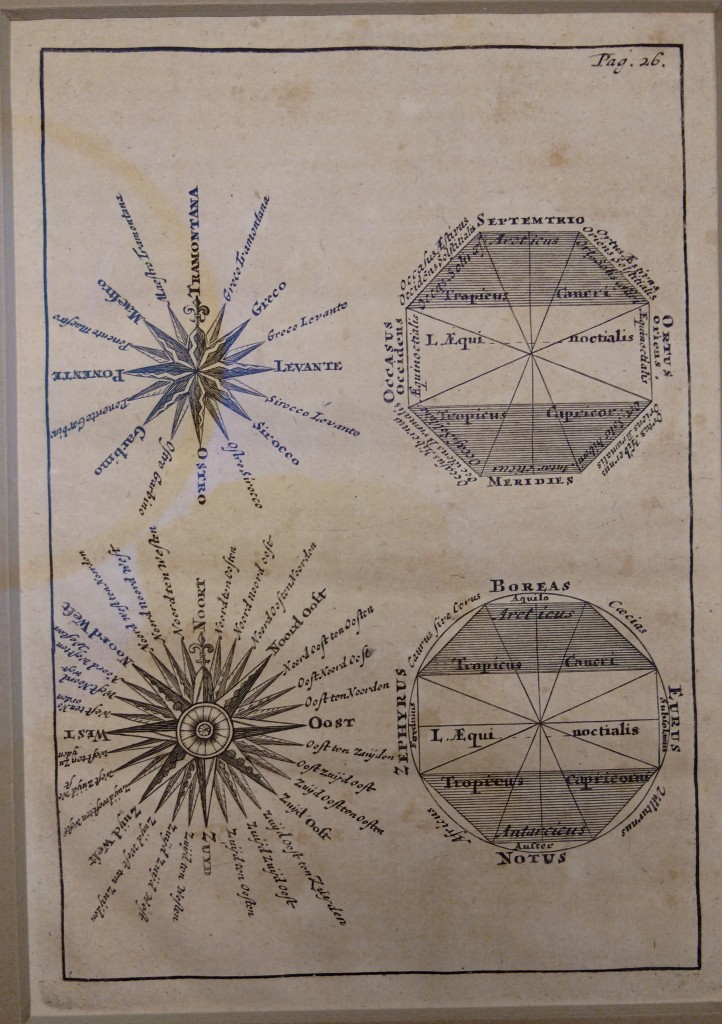
Compass Rose Andrew McCormick Collection
Feb 4
They can’t find it! No!!
Feb 11
Yes, they have it!
One small leaf in a frame with four different types of compass illustrations
Back of frame – dated “Chiven 1799” but sticker on bottom says “Chiven 1729” ?
Top left compass
• Similar design to a star with spiked ends and a fleur de lis like design at the top presumably pointing north
• The star has “squiggles” instead of straight compass line designs at the center
• Italian?
• The east word means “up” – sun rising
• The west word means “down” – sun setting
Bottom left compass
• Closer to what modern-day compasses look like with many spiked ends and designs within the spikes, along with a wheel at the center
• Fleur de lis-like spike for north
• Dutch
• More directions than the top left
Picture time!
xXx
Archidoxorum Aureoli Ph. Theophrasti Paracelsi de secretis naturae mysteriis, libri decem, quorum tenorem versa pagella dabit. His accesserunt libri De tinctura physicorum, De praeparationibus. De vexationibus alchimistarum, De praeparationibus, De vexationibus alchimistarum, De cementis metallorum & De gradationibus eorundem. Singula per Gerardum Dorn è germanico sermone latinitati nuperrimè donata.
By Paracelsus 1493-1541
With Dorn, Gerhard, 16th C. & William C. Gibson History of Medicine and Science Collection
Published: Basileae, Per Petrum Pernam 1570
WZ240.P23.1570
Mar. 3
Oh my god this is so cool!!!
“But the story of a book evidently does not end with its creation. How it is then put to use, by whom, in what circumstances, and to what effect are all equally complex issues.” (Broadview Reader in Book History 270)
Animal skin cover written and scratched / inked, very worn – one very used book
• scratches are crossing lines or scribbles – testing?
• maybe a word or two, but not done nicely
• front cover is coming apart in layers at the center
• animal skin cover has small holes, the spine a bit ripped off at the top and bottom
Flyleaves
• also have experimental writing in it by many different types of pens and ink, thick and thin and dark and light, one recto with a big 47 on it
• very worn, dirty, stained, bent edges, small holes
Content
• book is printed
• Dedication is in printed in italics
o Signed Gerardus Dorn
• has catchwords & little crosses at the bottom corners next to the page numbers
• There was a big massive stain of some sort that went through many of the pages
• can see the ink splatters and lines at the bottom from the printing
• all chapters have big capital headings and illuminated initials
• correcting of spelling & crossing out occurs throughout
“In other words, an editor cannot avoid making judgments about the author’s intention on the basis of the available evidence; strength of those judgments, in turn, will depend on his historical knowledge and his literary sensitivity.” (Broadview Reader in Book History 141)
First page of content – corrections!
• annotated and corrected by a brown ink, annotations in a cursive hand
• top page was ripped off and covered/re-glued back on
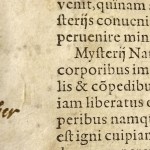
Cut off marginalia words – pg. 2
pg. 2
• cut off marginalia? why?
pg. 94
• corrections & marginalia
• the text at the bottom goes from justified to centered
pg 126
• big ink splatter
• looks to be the same ink as the corrector/annotator
pg 137
• Cap (thorn?) m? _ in a box top right corner
pg 141
• top right corner between two horizontal lines – more writing
• guitpiy?
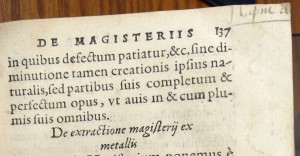
Chapter number noted – pg. 137
pg 175-178
• top corner of page ripped
pg 183
• more ink splatters at top right corner
pg 207
• writing and scribbling at end of this chapter
• then nice small writing on same page for beginning of next ch
pg 209
• more excited writing
• possibly referencing the same thing as at beginning of this ch on pg 207
pg 253
• more writing referencing certain chapters?
• “Caput primus” – first chapter
Mar 4
pg 257
• more upper corner marginalia underlined & some scribbles
PAUSE – DEER SKIN SCROLL FROM DUBAI CAME INTO RARE BOOKS
• MEDIEVAL ISRAELI BIBLICAL SCROLL ON RED DEER SKIN
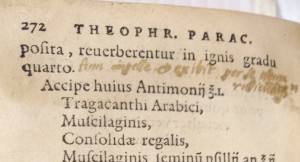
Ink that has gotten wet – pg 272
pg 272
• unusually thick marginalia – was wetted by something, the ink has expanded
pg 273 – 274
• thick ink also wetted and expanded
• bottom half of the page at the spine is ripped but re-glued to page 274 – looks like a new leaf added into the beginning of a quire, but is not?
PAUSE AGAIN – LOOKED AT A JAR CAP FROM MESOPOTAMIA WRITTEN IN SUMARIAN (according to the seller)
eebo – advanced search bibliographic b3539
Mar 15
“In the first place, a large number of people, machines, and materials must converge and act together for [the book] to come into existence at all.” (Broadview Reader in Book History 269)
pg 273-274
• the bottom half ripped part appears as a ripped out page reattached, but reattached in a way where the stub appears inserted – while the stub is glued over the area ripped on the page, the page does not appear displaced proportionally, which is fascinating
o normally, regluing a page to the stub it was ripped from will cause a the two to overlap (where it is glued), and therefore be disproportionate to the book but this one is not
o stub looks inserted and adhered to the ripped page in a way where it could be almost seamlessly a part of the page had it not been coming apart from age – but at the same time it doesn’t look like it was inserted because it seems a part of the quire
•
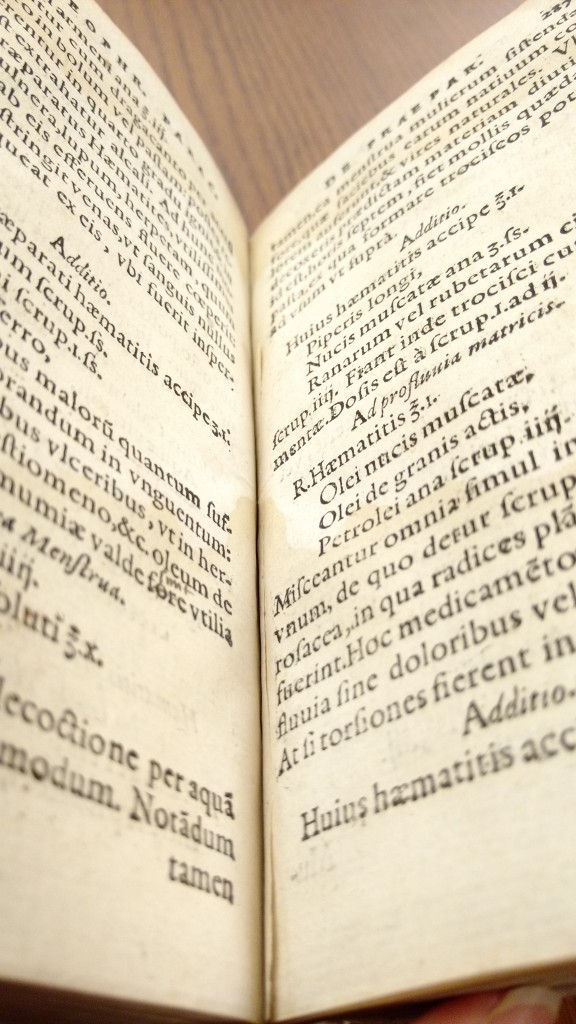
Stubs coming away from the page – pg 237
pg 287—288
• same ripped stub insert at the bottom half on page 287 side with the same overlap where it was reattached to the ripped page, adhered seamlessly to the page in certain parts, coming away from the page in others, like pg. 273-274
• this is the end of the quire (8 leafs), I think the stub was inserted during production when the middle (spine/binding area) of the quire for some reason ripped on the bottom half and had to be reattached with an extra piece at of parchment
pg 290
• different more modern hand in black/grey ink (not the brown), printed letters rather than cursive
• “adnfctione” – though d might be cl, n might be u and squished in inserted f might be a long s (strange for modern hand?)
pg 289-293
• bottom corners are all individually folded quite equally in shape into pages 289, 291, & 293
• though 289 & 291 are identically folded whereas 293 is a little smaller
• noting important pages as we do now? or accidental folds that were pulled apart
pg 317
• back to the first corrector/annotator in the brown ink
• boxed “& extra” and noted something small in the top right hand of that box
pg 330
• corrections written in modern hand and ink (i think?) – written in printed letters, dark ink
pg332-336
• correcting page numbers in top hand corners printed wrongly
Mar 24
pg 362-363
• bottom sections of the text are “boxed” – whole chunks of text might have been important to the reader (or significantly wrong, but I don’t think that’s the case because there are no real corrections made)
pg 364
• some underlining and a squiggle in the margin parallel to the text indicating an important portion of the text to the reader again
pg 365
• a bit of the bottom section of text is boxed
pg 369
• top corner boxed – 1573
pg 373
• top corner, not boxed – 28(5?)9 (a really big 9, or something else entirely)
“[Bibliography] includes the study of bookmaking and of the manufacture of the materials of which books are made…of the methods of printing and binding, of the practices of publication and bookselling it includes the whole typography and the whole of paleography.” (Broadview Reader in Book History 7)
pg 386-387
• another stub was adhered to the first page of a quire (pg 386), this time the stub glued very, very close to the text, almost overlapping it, the top half coming away from age
• this stub is more visible than the previous one
pg 398-399
• end of the quire (8 leaves), the stub is adhered to pg 399
• it is coming away from the page very easily and is not, like the others, adhered in a way that suggests an attempt at making it undetectable / part of the actual page
• the edge of the stub is clearly visible, attached to the page or not, the top half has come away
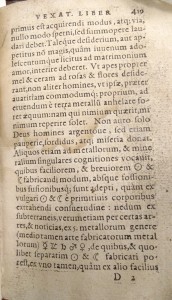
Exceptionally dirty page – pg. 419
• this specific quire is also loosening at the bottom from its binding to the spine of the book
pg 398/399 – 428/429
• pages get very dirty in this section, darkened with dirt or ink or just a lot of use
• this section of exceptionally dirtied pages begin at the book D. Pil. Theophrasti Paracelsi vexatio- num liber. and ends just a page before this short book ends
• this specific section features symbols printed into the text such as crescent moons and the like
pg 402-403
• another stub more seamlessly adhered to than the previous but the stub is not as straight cut (ripped)
WHOAA STUBS ON EVERY PAGE BETWEEN PG 402-415
• these seem to be different, many not spanning up the whole page but mostly on the top and bottom
• these pages seem ripped not cut
• is this due to rebinding? is this why this section is exceptionally dirty pages?
• also pg 414 is wrongly numbered as 514
